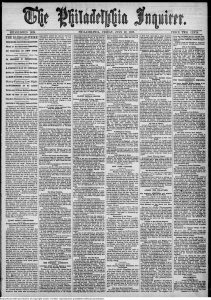Newspaper Cover Reporting Labor Strikes (1877)
This source is the front page of a newspaper published on July 27, 1877 by The Philadelphia Inquirer. In the first line of the paper it mentions “The Railroad Strike.” It continues to inform the public of the status of the Railroad Strike happening across the country. At the time of this paper’s publishing, the railroads had begun to resume their normal operation, but strikes and riots were still taking place. In Chicago there are a reported ten men dead and over a hundred and fifty wounded by the military trying to end the strikes. Many of the protesters demanded fairer working conditions. Some of these conditions included an eight-hour work day, a five-day work week, and the abolition of child labor. In Pittsburgh, strikers were rioting against the proposed 10 percent reduction in wages. This source shows a prevalent example of how workers in the Gilded Age sought to counter labor and wealth inequalities by joining labor unions and striking.
Jacob Riis Photograph of Poor Housing (1888)

This source is a photograph taken by Jacob Riis on February 12, 1888 in New York City. Jacob Riis was a social reformer known as a muckraker. He spent most of his career capturing images of suffering immigrants and poor people who suffered from the systematic inequalities in the United States. The image shows an alley called Baxter Street in which many poor immigrants built make shift homes. In addition to these poorly constructed homes, many immigrants lived in arrangements that were dangerous, crowded, and had limited electricity and plumbing. His purpose in taking these photographs was to portray “how the other half lives,” referring to the lives of poor people during times of massive wealth inequality. Riis was successful in spreading awareness of people in poverty to the general public. These images were effective stirring emotion from the more well off in society and brought attention to a much needed improvement of housing.
Cartoon showing Capitalism in America (1892)

This source is a political cartoon posted in The Saturday Globe on July 9th,1892. In the cartoon there are two versions of Andrew Carnegie standing on top of a money box. One of the Carnegie figures is seen with a stern look on his face pointing to a piece of paper he has in his hand that states “Notice: Wages Reduced 20 Percent.” The other Carnegie figure has a great smile on his face and in one hand is distributing a $5000 check to a man from Scotland and in the other hand is donating a library to the mayor of Pittsburgh. This source shows how Andrew Carnegie was viewed as a classic capitalist. He exploited his workers, paying them the lowest possible wages, while achieving moral redemption through his philanthropic works. The Carnegie Steel Company was seen as one the earliest corporation to implement large scale vertical and horizontal integration strategies into its business model. Carnegie along with other wealthy business owners like JP Morgan and John Rockefeller took advantage of the opportunity to grow their businesses during the late nineteenth century. However, in 1890 the Sherman Anti-Trust Act was passed in an effort to outlaw these monopolistic practices and redistribute wealth.
Photograph of Boys at the Carlisle Indian School (1899)

This source is a photograph taken on June 6, 1899 in Carlisle, PA. In the photo there is a group of boys standing in a field. These boys are part of the Carlisle Indian School and have left their families in order to become “Americanized.” The boys are dressed in formal attire and have been in classes make them more “civilized.” The Carlisle Indian School was one example of how white people asserted their power and tried to assimilate the Native Americans into society. Native Indians in the United States faced a hard path to citizenship. One path to citizenship was to leave your family and become assimilated into American society through an institution like the Carlisle Indian School. These assimilation schools stripped the Indians of their tribal identity and forced “American” culture upon them. Inherently, many Indians did not benefit from the rights of citizenship until 1924 when Congress passed legislation making all Indians American citizens. After this piece of legislation, Indians still faced many issues of inequality in the United States.
Photograph of Triangle Shirtwaist Company Fire (1911)

This source is a photograph taken on March 25, 1911 in New York City. The photographer is unknown, but it is part of the Hulton and Getty Archives. In the photograph is a policeman standing in the street looking over the aftermath of the Triangle Shirtwaist Company fire. Along with debris there are also dead bodies in the street. In total, 146 workers lost their lives in the fire. This photograph is intended to capture the emotion of its viewers with the hope that there will be industrial labor reform. A common practice at the time was to lock the doors out of the factory in order to prevent the abuse of break time and theft. If the factory owners hadn’t locked the exit doors, many of the workers would not have died. This fire came after a major strike by textile workers in 1909. Incidents such as these struck deep with the working class community and created a platform for the progressive movement. Laborers in factories like the Triangle Shirtwaist factory faced working conditions that were drastically unequal to their employers and unionized to seek a balance.

